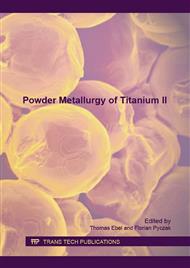p.44
p.55
p.68
p.75
p.85
p.94
p.107
p.113
p.118
Study of Titanium Metal Matrix Composites Reinforced by Boron Carbides and Amorphous Boron Particles Produced via Direct Hot Pressing
Abstract:
Nowadays, the demands for materials with high strength based on a titanium matrix are increasing. The manufacturing of titanium composites through low cost and near-net-shape techniques is a challenge for the industry. There are different processing routes to meet these requirements of the market. As it is well known fast powder metallurgical densification techniques could satisfy these needs. In the present work, several titanium metal matrix composites (TiMMCs) have been fabricated by using a fast hot consolidation technique, namely direct hot pressing (dHP) in order to reduce the manufacturing time. Through a pressure assisted sintering with direct heating of a pressing die the consolidated composites can be formed directly from powders in a short period of time (15 min). The matrix materials were selected from two titanium grade 1 powders and as reinforcement materials boron carbide and boron amorphous particles were employed. Varying the reinforcement’s content in addition to their particle size, their influence on the composites behaviour was expected. Furthermore in this research work, the mechanical and microstructural characterisation of the specimens was carried out in order to identify the best combination of process parameters, material reinforcement and matrix powders.Nowadays, the demands for materials with high strength based on a titanium matrix are increasing. The manufacturing of titanium composites through low cost and near-net-shape techniques is a challenge for the industry. There are different processing routes to meet these requirements of the market. As it is well known fast powder metallurgical densification techniques could satisfy these needs. In the present work, several titanium metal matrix composites (TiMMCs) have been fabricated by using a fast hot consolidation technique, namely direct hot pressing (dHP) in order to reduce the manufacturing time. Through a pressure assisted sintering with direct heating of a pressing die the consolidated composites can be formed directly from powders in a short period of time (15 min). The matrix materials were selected from two titanium grade 1 powders and as reinforcement materials boron carbide and boron amorphous particles were employed. Varying the reinforcement’s content in addition to their particle size, their influence on the composites behaviour was expected. Furthermore in this research work, the mechanical and microstructural characterisation of the specimens was carried out in order to identify the best combination of process parameters, material reinforcement and matrix powders.
Info:
Periodical:
Pages:
85-93
Citation:
Online since:
August 2016
Keywords:
Price:
Сopyright:
© 2016 Trans Tech Publications Ltd. All Rights Reserved
Share:
Citation:


